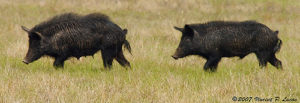27
Feb
Poisoning Feral Hogs Raises Safety and Environmental Concerns
(Beyond Pesticides, February 27, 2017) Texas has been dealing with a feral hog issue for many years, however recently Texas Agriculture Commissioner Sid Miller approved the use of a toxic rodenticide in an effort to control feral hog populations, a decision hunters and trappers oppose because the pesticide will poison prey and wreak havoc on ecosystems where the hogs live. The estimated population of the feral hog population is about 1.5 million in the state of Texas, where they can cause extensive damage to property, crops, and native wildlife.
 Wild hogs have been considered to be one of the most destructive invasive species in the U.S. The feral hog population, close to six million, span 39 states and four Canadian provinces. Commissioner Miller, in announcing the widespread use of toxic pesticide referred to the problem as the “feral hog apocalypse.”
Wild hogs have been considered to be one of the most destructive invasive species in the U.S. The feral hog population, close to six million, span 39 states and four Canadian provinces. Commissioner Miller, in announcing the widespread use of toxic pesticide referred to the problem as the “feral hog apocalypse.”
Damage caused by wild hogs has been estimated to reach well into the millions. Smithsonian Magazine has reported the annual damage caused by feral hog populations to be around $400 million. The Texas Parks and Wildlife website states that hogs are opportunistic omnivores. Feral hogs enjoy eating domestic agricultural crops, such as corn, soybeans, peanuts, potatoes, watermelons and cantaloupe. They can cause damages to livestock by damaging habitat and grazing lands via rooting and trampling activities. They are notorious for damaging livestock feeders and destabilizing wetlands, springs, and creeks. Feral hogs do not actively hunt, though they have been known to be aggressive to smaller animals, such as fawns, young lambs, and kid goats.
For many years, Texas has relied on hunters and land owners to trap the feral hogs in order to control the populations and contain the damage they cause. Texas has given hunters a year round pass to hunt and capture these animals without limits. Some Texans even take to the skies in helicopters to shoot these pigs. Many hunters are not pleased with the Agriculture Commissioner’s decision to switch to a poison control method. In the past two days since Sid Miller’s decision hunters have petitioned the move and have gathered more than 1,200 signatures in opposition to the poison control.
“We don’t think poison is the way to go,” said Eydin Hansen, President of the Texas Hog Hunter Association, in an interview with north Texas’ local CBS news station. Mr. Hansen has been hunting hogs since he was 16, not only for sport, but to feed his family. He said, “It’s a way to feed your family. . .If this hog is poisoned, do I want to feed it to my family? I can tell you, I don’t.”
Aside from the risk of eating a contaminated hog, hunters and conservationists are concerned that the rodenticide will inevitably contaminate non-target organisms. “If a hog dies, what eats it? Coyotes, buzzards. . .” said Mr. Hansen. “We’re gonna affect possibly the whole ecosystem.” Once the animal dies from ingesting the toxic material, it could be eaten by other animals. The body will inevitably decompose, potentially releasing toxicants, those not metabolized as well as metabolites, into the environment.
The product approved by the Agricultural Commissioner is branded as Kaput Feral Hog Lure. The active ingredient of the rodenticide formulation is the anticoagulant warfarin, a drug that is widely used to control rat and mice populations as well as prescribed by doctors to prevent blood clots. The rodenticide’s label explicitly states, “This product maybe toxic to fish, birds and other wildlife. Dogs and other predatory and scavenging mammals and birds might be poisoned if they feed upon animals that have eaten the bait.”
The secondary poisoning associated with the use of rodenticides in the outdoor environment will occur when unintended organisms consume the bait. Those advocating the use of the Kaput rodenticide focus on the manufacturer’s dispenser for the rodenticide that is specially designed to allow only hogs to feed on the bait. This, however, does not protect animals that feed on the poisoned hog. The bait also is designed to dye the flesh and muscle of the poisoned animal blue, notifying hunters that this animal has ingested the poison. Commissioner Miller makes a cost argument for pushing poison, saying it will save the state $900,000, which was earmarked for feral hog control research.
Beyond Pesticides stands behind the hunters on this matter. As in many other cases, there are safe sustainable alternatives that protect human and environmental health. Trapping and hunting present a sustainable option, incentivizing approaches that are a much safer option for population control without risks to the environment and human health.
All unattributed positions and opinions in this piece are those of Beyond Pesticides.
Sources: CBS 11, Smithsonian, Texas Parks & Wildlife










